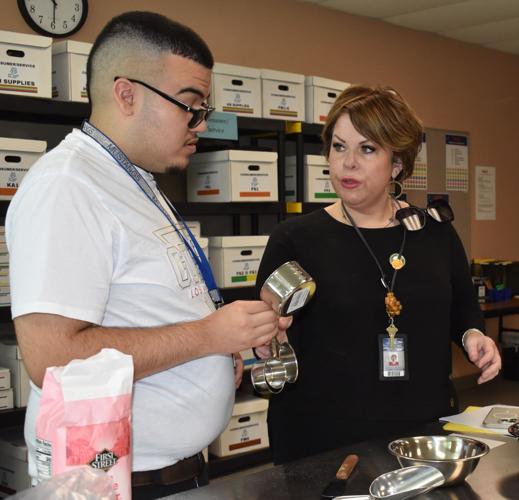This article was written and Published by Kim Smith— September 3, 2024

Alex Espino was on a mission Friday. After clocking into work, he discovered he’d been assigned to consumer services and his job that day was to measure out sugar.
The 17-year-old special education student methodically read and re-read the instructions provided to him and he set about gathering his supplies and performing the task.
On the other side of the room, Aaron Garcia, 16, had been assigned to business marketing and he was busy alphabetizing numerous names.
Every school day, Garcia, Espino and 18 other special needs students ages 14 to 21 spend an hour in Sahuarita Unified School District’s new “practical assessment exploration system” lab at Sahuarita High School.
The grant-funded lab gives students the opportunity to learn new skills in such areas as business marketing, construction/industrial, computer technology, consumer services and processing production.
Heather Manzonelli, who is in her 13th year as a special education teacher in the district’s inclusion extended resources program, said every student will rotate through the five career paths and try to work their way through six levels of tasks.
Espino, for example, was working on the first level of consumer service, food measurement. After that, will come food preparation, kitchen appliances, food service, food weights, cloth measurement, hand sewing, machine sewing, cloth construction and housekeeping/custodial.
In business marketing, alphabetizing will be followed by identification/filing, numerical sorting, collating, making change, ten key calculator, cash register and typing.
Better futures
SUSD Director of Student Services Jess Banhie said the broad goal of the lab is “profound.”
“Each student will have the opportunity to go through all five different components, and then they get to figure out what they’re really interested in,” Banhie said. “So, they’re finding a sense of belonging and they’re finding some self efficacy and some self determination along the way, and then this may help guide those post secondary outcomes.”
Along one wall of the lab, storage shelves hold boxes containing each of the materials needed for each job. Plus, there are the tools needed to perform some of the tasks, a cash register, vacuum cleaner, microwave, sewing machine, tool boxes and ironing board. There’s also a small food pantry.
The lab is just one component of the extended resource program. The students also learn functional math and reading skills along with daily living skills.
The students in the extended resource program run the gamut from those with severe intellectual and medical disabilities to those who have mild or moderate intellectual disabilities, Manzonelli said.
As a result the positive post-graduation outcomes will look different for each student, Banhie said.
“We might have a student who a meaningful, positive post-secondary outcome for them may be going to community college or going to Project Focus or Project Search at the university and in conjunction with JTED, it may be a student participating in work a supported work environment post high school,” Banhie said.
It could also be meaningful participation in a recreation program after high school, additional vocational training or the ability to have meaningful relationships with the people that they interact with in their lives after high school, she said.
Some might work through all of the career paths and levels in a year, in which case they’ll be given more tasks in subsequent years. Others might take years to work their way through.
Throughout their high school experience, Banhie said they focus on building social skills, communication skills and building a sense of belongingness so they can meaningfully participate in their community.
Community partnerships
Thanks to partnerships with such organizations as Workability, United Cerebral Palsy and the University of Arizona Sonoran Center for Excellence in Disabilities, the students have the opportunity — before they even graduate — to work off-campus at such places as the Amado Food Bank, Reid Park Zoo and Tractor Supply. Some students shop for Triple Play and collect recyclables from the McGee Ranch area.
During their time in the lab, the students time themselves performing their tasks and other data is collected, Banhies said.
That assessment data is crucial, Banhie said.
“It can help us predict future job satisfaction, future job success. It looks at the level of assistance needed by a student, the speed at which they work, at the number of attempts that they need to complete a task, the quality of work, and, you know, most importantly, their interest in that that work or that job,” Banhie said. “So it really just brings it all back together and is really helpful in terms of informing instruction for the teacher.”
PAESAuthor.com, who created the lab, set it up over the summer and spent two days training Manzonelli and her inclusion assistants.
Banhie, who called the lab her “passion project,” said one of the best parts about the lab is they aren’t dictating to the students what their desire should be or what they should do next in life.
“We’re giving them all of these opportunities, and then hopefully what we can do is help them, once they figure out what they’re really interested in, to hone in on a specific area and then do extensive skill building in that area so that they can be successful, and do that when they leave,” she said.
Asked about the lab, Garcia said, “I think it’s pretty cool.”
His grandmother Maria Jordan is also thrilled with it.
“I’m hoping that he will get some kind of skill or end up finding out what he really likes to where he can find a place where they will accept him and he’ll be able to work just like a regular person,” Jordan said.
She said she’s always been happy with Sahuarita’s extended resource program.
“I think every year he always does something better, you know, he betters himself every year,” Jordan said.